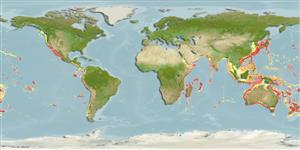>
Anguilliformes (Eels and morays) >
Nettastomatidae (Duckbill eels)
Etymology: Nettastoma: Greek, netta = duck + Greek, stoma = mouth (Ref. 45335); parviceps: From the Latin parvus meaning little and caput meaning head, referring to the slightly smaller size of the head of this species compared to that of N. melanura, the only other species of the genus known to Günther..
More on author: Günther.
Environment: milieu / climate zone / depth range / distribution range
Ecologia
marinhas bentopelágico; intervalo de profundidade 60 - 1190 m (Ref. 40819). Deep-water
Indo-Pacific: bitemperate distribution, recorded from Japan, Hawaii, eastern Australia, and southeastern Africa. Southeast Pacific: Chile (Ref. 9068). Rare or absent in equatorial waters.
Tamanho / Peso / Idade
Maturity: Lm ? range ? - ? cm
Max length : 82.0 cm TL macho/indeterminado; (Ref. 6591)
Descrição suscinta
Chaves de identificação | Morfologia | Morfometria
Vértebras: 230. SO5 pore normally absent. Lateral line pores 49-58. Median vomerine teeth not enlarged. Posterior nostril above posterodorsal corner of eye. Other characteristics: Color gray; vertical fins black-edged; snout gray-black; iris and opercular regions silver.
Inhabits the continental slope (Ref. 7300, 75154) and shelf (Ref. 75154).
Ciclo de vida ou comportamento de acasalamento
Maturities | Reprodução | Spawnings | Egg(s) | Fecundities | Larvas
Castle, P.H.J., 1986. Nettastomatidae. p. 190-191. In M.M. Smith and P.C. Heemstra (eds.) Smiths' sea fishes. Springer-Verlag, Berlin. (Ref. 6591)
Status na Lista Vermelha da UICN (Ref. 130435)
Ameaça para os humanos
Harmless
Uso pelos humanos
Pescarias: sem interesse
Ferramentas
Relatórios especiais
Baixar XML
Fontes da internet
Estimates based on models
Preferred temperature (Ref.
123201): 7.8 - 17.5, mean 11.5 °C (based on 548 cells).
Índice de diversidade filogenética (Ref.
82804): PD
50 = 0.5312 [Uniqueness, from 0.5 = low to 2.0 = high].
Bayesian length-weight: a=0.00089 (0.00036 - 0.00223), b=2.98 (2.77 - 3.19), in cm total length, based on LWR estimates for this (Sub)family-body shape (Ref.
93245).
Nível Trófico (Ref.
69278): 3.5 ±0.5 se; based on size and trophs of closest relatives
Resiliência (Ref.
120179): Baixo, tempo mínimo de duplicação da população 4,5 - 14 anos (Assuming tmax>10).
Fishing Vulnerability (Ref.
59153): Moderate to high vulnerability (53 of 100).
